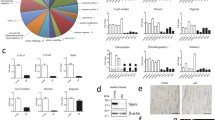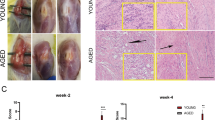Abstract
The musculoskeletal system (muscle–tendon–bone) demonstrates numerous age-related changes, with modifications in tendons the least well studied, although increased predisposition to tendinopathy and rupture have been reported. In order to gain insights into the basis of age-associated increase in tendon injuries, we compared Achilles and tibialis anterior tendons and myotendinous junctions (MTJs) from 3- to 5- and 22- to 25-month-old rats for underlying structure and composition. Significant decreases were observed by qRT-PCR for collagen I, III, and V mRNA expression in tendons of old rats, but immunostaining detected no apparent differences in collagen I and V expression on the protein level. Tendons of old compared with young rats had decreased mRNA expression levels of proteoglycan 4 (PRG4) and elastin (Eln), but no differences in the mRNA expression of connective tissue growth factor, TGF-beta 1, or stromal cell-derived factor 1. For PRG4, immunostaining showed good correlation with qRT-PCR results. This is the first study to show reductions in PRG4 in tendons and MTJs of old rats. Decreased PRG4 expression in tendons could result in increased tendon stiffness and may be associated with decreased activity in the elderly. The diminished collagen mRNA expression in combination with decreased PRG4 and Eln mRNA expression may be associated with increased risk of tendon injury with aging.



Similar content being viewed by others
Abbreviations
- CTGF:
-
Connective tissue growth factor
- ECM:
-
Extracellular matrix
- EGF:
-
Epidermal growth factor
- Eln:
-
Elastin
- IGF:
-
Insulin-like growth factor
- FGF:
-
Fibroblast growth factor
- GDF:
-
Growth differentiation factor
- LOX:
-
Lysyl oxidase
- MTJs:
-
Myotendinous junctions
- PRG4:
-
Proteoglycan 4
- SDF1:
-
Stromal cell-derived factor 1
- TBA:
-
Tibialis anterior muscle
- TGFb:
-
Transforming growth factor beta
References
Augustin H, Partridge L (2009) Invertebrate models of age-related muscle degeneration. Biochim Biophys Acta 1790:1084–1094
Banos CC, Thomas AH, Kuo CK (2008) Collagen fibrillogenesis in tendon development: current models and regulation of fibril assembly. Birth Defects Res C Embryo Today 84:228–244
Cheng J, Wang Y, Wang Z, Yang M, Wu Y (2010) Differential regulation of proteoglycan-4 expression by IL-1alpha and TGF-beta1 in rat condylar chondrocytes. Tohoku J Exp Med 222:211–218
Dressler MR, Butler DL, Wenstrup R, Awad HA, Smith F et al (2002) A potential mechanism for age-related declines in patellar tendon biomechanics. J Orthop Res 20:1315–1322
Duncan MR, Frazier KS, Abramson S, Williams S, Klapper H et al (1999) Connective tissue growth factor mediates transforming growth factor beta-induced collagen synthesis: down-regulation by cAMP. FASEB J 13:1774–1786
Frenette J, Tidball JG (1998) Mechanical loading regulates expression of talin and its mRNA, which are concentrated at myotendinous junctions. Am J Physiol 275:C818–C825
Funakoshi T, Schmid T, Hsu HP, Spector M (2008) Lubricin distribution in the goat infraspinatus tendon: a basis for interfascicular lubrication. J Bone Joint Surg Am 90:803–814
Grotendorst GR, Okochi H, Hayashi N (1996) A novel transforming growth factor beta response element controls the expression of the connective tissue growth factor gene. Cell Growth Differ 7:469–480
Heinemeier KM, Olesen JL, Haddad F, Langberg H, Kjaer M et al (2007) Expression of collagen and related growth factors in rat tendon and skeletal muscle in response to specific contraction types. J Physiol 582:1303–1316
Heinemeier KM, Bjerrum SS, Schjerling P, Kjaer M (2013) Expression of extracellular matrix components and related growth factors in human tendon and muscle after acute exercise. Scand J Med Sci Sports. doi:10.1111/j.1600-0838.2011.01414.x
Hess GW (2010) Achilles tendon rupture: a review of etiology, population, anatomy, risk factors, and injury prevention. Foot Ankle Spec 3(1):29–32
Jarvinen TA, Jozsa L, Kannus P, Jarvinen TL, Hurme T et al (2003) Mechanical loading regulates the expression of tenascin-C in the myotendinous junction and tendon but does not induce de novo synthesis in the skeletal muscle. J Cell Sci 116:857–866
Jarvinen TA, Kannus P, Maffulli N, Khan KM (2005) Achilles tendon disorders: etiology and epidemiology. Foot Ankle Clin 10:255–266
Kannus P (2000) Structure of the tendon connective tissue. Scand J Med Sci Sports 10:312–320
Kjaer M, Magnusson P, Krogsgaard M, Boysen Moller J, Olesen J et al (2006) Extracellular matrix adaptation of tendon and skeletal muscle to exercise. J Anat 208:445–450
Kjaer M, Langberg H, Heinemeier K, Bayer ML, Hansen M et al (2009) From mechanical loading to collagen synthesis, structural changes and function in human tendon. Scand J Med Sci Sports 19(4):500–510
Koch M, Schulze J, Hansen U, Ashwodt T, Keene DR et al (2004) A novel marker of tissue junctions, collagen XXII. J Biol Chem 279:22514–22521
Kohrs RT, Zhao C, Sun YL, Jay GD, Zhang L et al (2011) Tendon fascicle gliding in wild type, heterozygous, and lubricin knockout mice. J Orthop Res 29:384–389
Kostrominova TY (2011) Application of WGA lectin staining for visualization of the connective tissue in skeletal muscle, bone, and ligament/tendon studies. Microsc Res Tech 74:18–22
Law DJ, Allen DL, Tidball JG (1994) Talin, vinculin and DRP (utrophin) concentrations are increased at mdx myotendinous junctions following onset of necrosis. J Cell Sci 107(Pt 6):1477–1483
Lee SY, Nakagawa T, Reddi AH (2008) Induction of chondrogenesis and expression of superficial zone protein (SZP)/lubricin by mesenchymal progenitors in the infrapatellar fat pad of the knee joint treated with TGF-beta1 and BMP-7. Biochem Biophys Res Commun 376:148–153
Li W, Zhou J, Chen L, Luo Z, Zhao Y (2011) Lysyl oxidase, a critical intra- and extra-cellular target in the lung for cigarette smoke pathogenesis. Int J Environ Res Public Health 8:161–184
Livak KJ, Schmittgen TD (2001) Analysis of relative gene expression data using real-time quantitative PCR and the 2(-Delta Delta C(T)) method. Methods 25:402–408
Lu P, Zhang GR, Song XH, Zou XH, Wang LL et al (2011) Col V siRNA engineered tenocytes for tendon tissue engineering. PLoS One 6:e21154
Magnusson SP, Narici MV, Maganaris CN, Kjaer M (2008) Human tendon behaviour and adaptation, in vivo. J Physiol 586(1):71–81
Maki JM (2009) Lysyl oxidases in mammalian development and certain pathological conditions. Histol Histopathol 24:651–660
Milgrom C, Schaffler M, Gilbert S, van Holsbeeck M (1995) Rotator-cuff changes in asymptomatic adults. The effect of age, hand dominance and gender. J Bone Joint Surg Br 77:296–298
Nakatani T, Marui T, Hitora T, Doita M, Nishida K et al (2002) Mechanical stretching force promotes collagen synthesis by cultured cells from human ligamentum flavum via transforming growth factor-beta1. J Orthop Res 20:1380–1386
Narici MV, Maganaris CN (2007) Plasticity of the muscle–tendon complex with disuse and aging. Exerc Sport Sci Rev 35(3):126–134
Niyibizi C, Kavalkovich K, Yamaji T, Woo SL (2000) Type V collagen is increased during rabbit medial collateral ligament healing. Knee Surg Sports Traumatol Arthrosc 8:281–285
Novince CM, Koh AJ, Michalski MN, Marchesan JT, Wang J et al (2011) Proteoglycan 4, a novel immunomodulatory factor, regulates parathyroid hormone actions on hematopoietic cells. Am J Pathol 179:2431–2442
Oliva F, Gatti S, Porcellini G, Forsyth NR, Maffulli N (2012) Growth factors and tendon healing. Med Sport Sci 57:53–64
Parkinson J, Samiric T, Ilic MZ, Cook J, Handley CJ (2011) Involvement of proteoglycans in tendinopathy. J Musculoskelet Neuronal Interact 11(2):86–93
Perez AL, Bachrach E, Illigens BM, Jun SJ, Bagden E et al (2009) CXCR4 enhances engraftment of muscle progenitor cells. Muscle Nerve 40:562–572
Rees SG, Dent CM, Caterson B (2009) Metabolism of proteoglycans in tendon. Scand J Med Sci Sports 19(4):470–478
Riley G (2008) Tendinopathy—from basic science to treatment. Nat Clin Pract Rheumatol 4:82–89
Schneider CA, Rasband WS, Eliceiri KW (2012) NIH image to ImageJ: 25 years of image analysis. Nat Methods 9:671–675
Smith K, Rennie MJ (2007) New approaches and recent results concerning human-tissue collagen synthesis. Curr Opin Clin Nutr Metab Care 10:582–590
Spittau B, Krieglstein K (2012) Klf10 and Klf11 as mediators of TGF-beta superfamily signaling. Cell Tissue Res 347(1):65–72
Thorpe CT, Streeter I, Pinchbeck GL, Goodship AE, Clegg PD et al (2010) Aspartic acid racemization and collagen degradation markers reveal an accumulation of damage in tendon collagen that is enhanced with aging. J Biol Chem 285:15674–15681
Tidball JG, Lin C (1989) Structural changes at the myogenic cell surface during the formation of myotendinous junctions. Cell Tissue Res 257:77–84
Turner CE, Kramarcy N, Sealock R, Burridge K (1991) Localization of paxillin, a focal adhesion protein, to smooth muscle dense plaques, and the myotendinous and neuromuscular junctions of skeletal muscle. Exp Cell Res 192:651–655
Untergasser A, Cutcutache I, Koressaar T, Ye J, Faircloth BC et al (2012) Primer3—new capabilities and interfaces. Nucleic Acids Res 40:e115
Voleti PB, Buckley MR, Soslowsky LJ (2012) Tendon healing: repair and regeneration. Annu Rev Biomed Eng 14:47–71
Welser JV, Rooney JE, Cohen NC, Gurpur PB, Singer CA et al (2009) Myotendinous junction defects and reduced force transmission in mice that lack alpha7 integrin and utrophin. Am J Pathol 175:1545–1554
Wood LK, Arruda EM, Brooks SV (2011) Regional stiffening with aging in tibialis anterior tendons of mice occurs independent of changes in collagen fibril morphology. J Appl Physiol 111(4):999–1006
Acknowledgments
This study was supported by NIH Grant AR-055624 (SVB) and IUSM-Northwest (TYK).
Author information
Authors and Affiliations
Corresponding author
Electronic supplementary material
Below is the link to the electronic supplementary material.
Supplemental Fig. 1
Evaluation of paxillin, talin and collagen XXII expression at MTJs of young rats. Immunostaining of MTJ regions of TBA tendons from young rats with antibodies against paxillin, talin and collagen XXII (red in A–C). DAPI (blue) was used to co-stain the nuclei. WGA-fluorescein (green in A and C) and anti-collagen type I antibodies (green in B) were used to visualize connective tissue. Arrows indicate increased protein accumulation at the muscle/tendon border. (PDF 2212 kb)
About this article
Cite this article
Kostrominova, T.Y., Brooks, S.V. Age-related changes in structure and extracellular matrix protein expression levels in rat tendons. AGE 35, 2203–2214 (2013). https://doi.org/10.1007/s11357-013-9514-2
Received:
Accepted:
Published:
Issue Date:
DOI: https://doi.org/10.1007/s11357-013-9514-2




